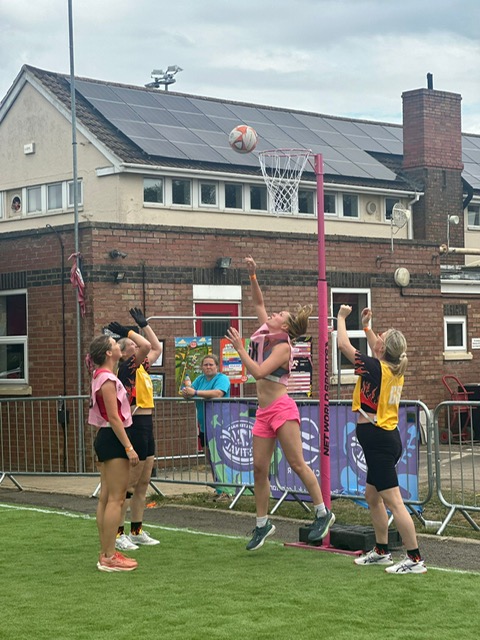Over the past few years, recreational netball has seen a surge in popularity among those aged 45 and above.
The sport’s fast-paced nature, agility demands, and team camaraderie make it appealing—but these very qualities can also increase injury risk if players are underprepared.
Netball and Injury Statistics in Over-40s
For many of us it is a typical pattern – we play sport through our childhood and maybe into our 20s. Then life gets busy. We start building a career, maybe start a family and time for sport evaporates. Then as we come out the other side and think we really should try to keep ourselves in shape, we often gravitate back to those activities we played before, none more so than Netball.
The research tells us that injury rates in community-level netball fall between 11 and 14 injuries per 1,000 playing hours. While much of this data mixes all ages, experts agree that injury risk increases with age, with adults experiencing more lower-limb issues—particularly ankle and knee sprains or strains.
Why the Over-40s Are More Susceptible
1. Reduced fitness and conditioning
It’s the conversation I have more than any other: ‘in our heads we stay the same, but physically we do not’. Age-related declines in muscle strength, flexibility, and coordination are normal. As we come back into sport from our 40s onwards, particularly something as dynamic as Netball it is vital to have a solid baseline – an ability to jump, land, pivot, and sprint. Without this, the body can become overwhelmed, often resulting in injury.
2. Inadequate warm-up and preparation
A client told me recently that there is no room to warm up around the indoor courts she plays on. There is space close by however, but very few people use it. My patient has an Achilles tendon injury.

A proper dynamic warm-up raises muscle temperature and joint mobility, preparing the body for action. Warm-ups overlooked or rushed by enthusiastic players can leave muscles cold, stiff, and injury-prone. If there is no convenient space to warm-up, you may need to find a slightly inconvenient space. Either way, neglecting your warm-up will increase your injury risk.
3. Poor technique on landings and direction changes
Recreational netball brings a lot of stop-start and rapid direction changes. A consensus of sports experts highlights poor landing and deceleration mechanics as top risk factors for netball injury3. Learning how to land on both feet with soft knees can dramatically reduce strain.
4. History of previous injury
We are a product of our journey. A previous ankle or knee injury can lead to lingering weakness or proprioception deficits, particularly if the rehab from this injury was insufficient. This can increase the likelihood of re-injury.
Reducing Your Risk: Practical Tips
- Invest in conditioning: a simple program of strength (especially lower body), balance, and agility exercises can go a long way. It doesn’t require heavy weights, or huge amounts of time. But it does need to get done. Consistently. Over time. At the right dosage.
- Warm-up smartly: 10–15 minutes of dynamic movements—high knees, leg swings, light plyometrics—to prime muscles and joints.
- Learn safe technique: focus on two-leg landings, knee alignment, and using hips during direction changes.
- Protect problem areas: if you’ve had prior ankle or knee injuries, ensure that you’ve had it thoroughly assessed and that the exercise you do reflects your history and your objectives.
- Listen to your body: rest is as important as training. Don’t push through pain—overuse and fatigue are known injury drivers. If you’re not fit to play, no matter how much your captain needs you because the team is short, sometimes you need to look after number 1!
When to Seek Help
If you’ve been sidelined by a netball injury—whether it’s an ankle sprain, knee strain, or lingering pain—it may not seem serious at first. But without proper assessment, small issues can evolve into bigger setbacks. It’s better the get things checked and dealt with early, rather than waiting for a more significant injury.
Ready to Play Pain-Free?
Want to chat about your current netball-related injury—or learn how to prevent one before it starts? Get in touch with our clinic. We offer tailored assessments, injury screening, and personalised conditioning programs designed especially for those over 45. Let’s keep you in the game—strong, safe, and confident.
- sciencedirect.com+15systematicreviewsjournal.biomedcentral.com+15scite.ai+15.
- sportsmedicine-open.springeropen.com+1springermedicine.com+1.
systematicreviewsjournal.biomedcentral.com+12bjsm.bmj.com+12jsams.org+12.
To sign up for Ed’s newsletter, click … HERE
Ed graduated from Birmingham University with an MSc in Physiotherapy in 2009.
He is an HCPC and CSP registered Physiotherapist who has worked in the NHS, private practice and in sport both in the UK and New Zealand, and he now specialises in working with people over the age of 50 who value their health and want to keep as active as possible for as long as possible.
In his spare time, you’ll find Ed spending time with his wife and two children, out running the local trails with his dog, or if he’s really lucky, out on the golf course.
Ed grew up in Stroud, the son of a local GP and he knows and loves the local communities in the Five Valleys and beyond. Being able to give back to the people of this wonderful part of the world is something that Ed considers a huge privilege.
For further information, visit Ed’s website by clicking HERE or Email: edvossphysio@gmail.com Call: 07542 940478






